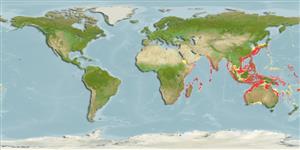分类 / Names
俗名 | 同种异名 | Catalog of Fishes(属, 种) | ITIS | CoL | WoRMS | Cloffa
Environment: milieu / climate zone / depth range / distribution range
生态学
海洋; 半咸淡水 礁区鱼类; 深度上下限 45 - 375 m (Ref. 33390). 熱帶; 39°N - 35°S, 23°E - 179°W (Ref. 5222)
Indo-West Pacific: east coast of Africa to Japan, Korea, South China Sea, Viet Nam, and Fiji. Unknown from the Red Sea and Persian Gulf.
印度-西太平洋: 非洲東岸至日本,韓國,南中國海,越南與斐濟。 未知的從紅海與波斯灣。
Length at first maturity / 大小 / 重量 / 年龄
Maturity: Lm ?, range 41 - ? cm
Max length : 65.0 cm TL 雄鱼/尚未辨别雌雄; (Ref. 4319); 最大体重: 4.0 kg (Ref. 5222)
背棘 (总数) : 11; 背的软条 (总数) : 14 - 15; 臀棘: 3; 臀鳍软条: 8. Distinguished by the following characteristics: juveniles are pale yellowish grey in color, with oval black blotch on body between bases of the 3rd to 9th dorsal fin spines and extending to the edge of the fin between 1st and 7th spines; semicircular pale band passes ventrally around the oval black blotch and isolates it from the dark brown band that begins broadly on nape and bifurcates just behind operculum, upper branch curving dorsally and expanding broadly over the basal half of the dorsal fin between 9th spine and 4th soft ray, lower branch also curving dorsally and expanding at the base of the last 4 dorsal-fin rays; presence of 2nd curved band, parallel to the one above, runs from interorbital area and rear edge of the eye to a black saddle spot on caudal peduncle; 3rd narrow dark brown band, from lower edge of eye to the subopercle and continues as a series of dark dots along ventral part of the body to the base of caudal fin; pale yellow fins, except where dark markings occur on dorsal fin; adults with faint or absent dark spots on body; fins are yellowish brown, triangular interspinous dorsal fin margins abruptly orange-yellow or brownish yellow; soft dorsal, anal and caudal fins shading to blackish distally with bluish white edge; body depth contained 2.6-3.1 times in SL; head length 2.3-2.5 times in SL; interorbital area slightly convex; 2-5 enlarged serrae at preopercle angle; slightly convex upper edge of operculum; maxilla reaches about to vertical at rear edge of eye; maxilla in adults with step on edge; posterior nostrils of adults larger than anterior ones; 2 rows of teeth on midlateral part of lower jaw; pyloric caeca 8-9 (Ref. 89707).
Reef-associated (Ref. 89707). Inhabits relatively deep water (Ref. 5222). Feeds on fishes and crustaceans (Ref. 89707).
栖息于相当深的水。 (参考文献 5222)
Life cycle and mating behavior
成熟度 | 繁殖 | 产卵场 | 卵 | 孕卵数 | 仔鱼
印度-西太平洋: 非洲東岸至日本,韓國,南中國海,越南與斐濟。 未知的從紅海與波斯灣。
Heemstra, P.C. and J.E. Randall, 1993. FAO Species Catalogue. Vol. 16. Groupers of the world (family Serranidae, subfamily Epinephelinae). An annotated and illustrated catalogue of the grouper, rockcod, hind, coral grouper and lyretail species known to date. Rome: FAO. FAO Fish. Synop. 125(16):382 p. (Ref. 5222)
世界自然保护联盟红皮书 (Ref. 130435: Version 2024-1)
人类利用
渔业: 自给性渔业
工具
特别资料
下载 XML
网络资源
Estimates based on models
Preferred temperature (Ref.
123201): 15.1 - 26.6, mean 20.7 °C (based on 556 cells).
Phylogenetic diversity index (Ref.
82804): PD
50 = 0.5000 [Uniqueness, from 0.5 = low to 2.0 = high].
Bayesian length-weight: a=0.01175 (0.00568 - 0.02430), b=3.04 (2.88 - 3.20), in cm total length, based on LWR estimates for this Genus-body shape (Ref.
93245).
营养阶层 (Ref.
69278): 4.0 ±0.66 se; based on food items.
回复力 (Ref.
120179): 低的, 最小族群倍增时间4.5 - 14 年 (Preliminary K or Fecundity.).
Fishing Vulnerability (Ref.
59153): Moderate to high vulnerability (46 of 100).
